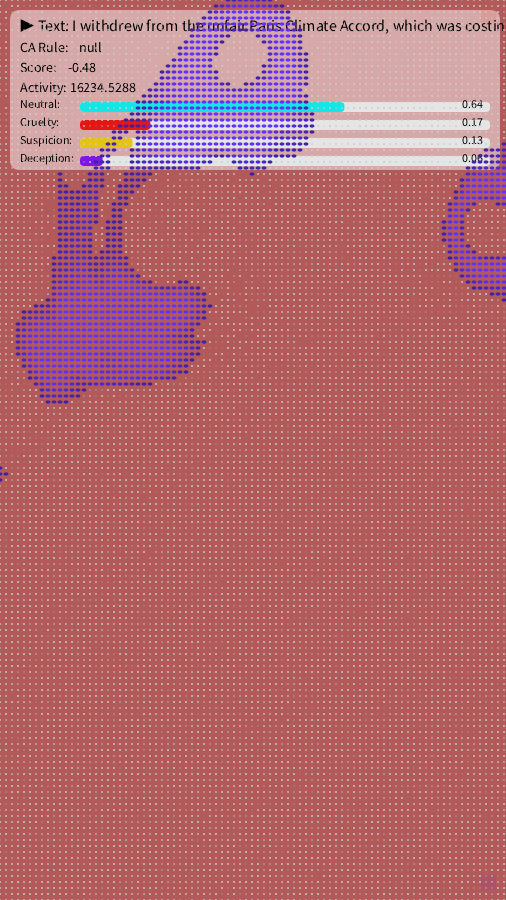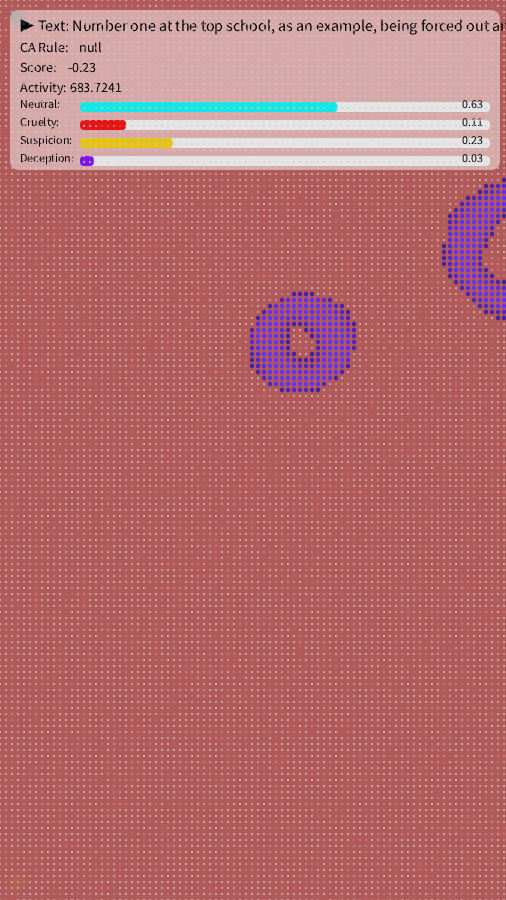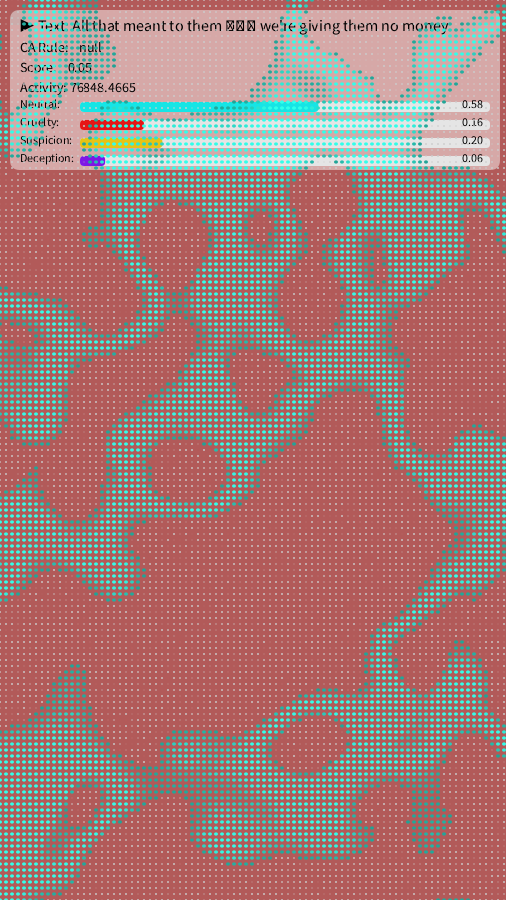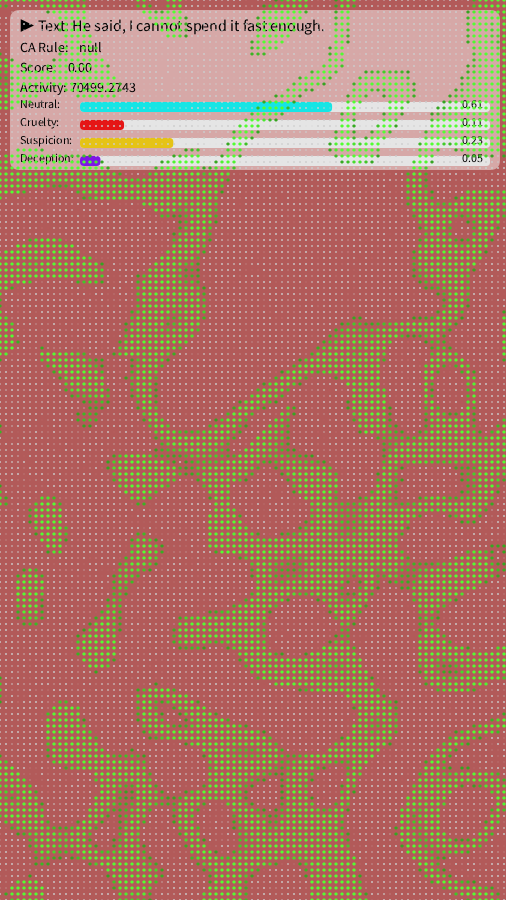Angela Ferraiolo


Data is often seen as a static entity, a body of information that waits to be sorted, classified, visualized and presented. Along these lines, our digital environments, the ‘data spaces’ we inhabit, are largely built on computational structures that process information according to predetermined, emotionally neutral rules. But the human experience of data and data systems is often deeply emotional, creating a tension between the affective experience of data and the procedural nature of computation. In an increasingly ‘datafied’ world, a more systemic view of data becomes interesting to artists. The dynamic relationship between data and emotion is an area that offers the potential for artistic and theoretical explorations.
My recent artistic research looked at political speech as a means of bridging the gap between static and dynamic views of data. Rather than presenting the meaning of the text through the well-known expressive lens (word frequency, tag clouds, etc) of data visualization, I explored a recent presidential address to congress, by tying the sentiment analysis of a text to the computational rules of an emergent system, allowing data to act as a transformative force that alters computational behavior.
This research draws on concepts from cellular automata theory, affective computing, and generative art. The idea was to research a system that uses sentiment analysis to score a political text for emotional content over multiple dimensions, then translates these emotional scores into specific computational parameters. The system continues by applying those parameters to modify both the rule structure and visual properties of a cellular automaton. Finally, this system creates a feedback loop where the automaton’s behavior influences subsequent emotional processing.
This research asks how data can function beyond the quantitative to use data not as a descriptive body of facts, but as a generative force that produces new computational realities.
Affective Computing and Sentiment Analysis
Affective computing was first formalized by Rosalind Picard (1997) and explores how computers can recognize, interpret, and process human emotions. The field evolved rapidly with advances in natural language processing and machine learning which enables increasingly sophisticated sentiment analysis of text.
An important aspect of affective computing, sentiment analysis involves computational schemes for analyzing the emotional tone or feeling behind written text, usually asking whether someone’s speech is positive, negative, or neutral in affect. Sentiment analysis is not unlike teaching a computer to read between the lines the same way humans do. When you read a movie review that says “This film was absolutely amazing!” you can tell the person loved it. Or if someone writes “Worst customer service ever,” you know they’re upset. Sentiment analysis helps computers recognize emotional cues automatically. In analyzing a text, sentiment technologies look for clues like specific words (great, terrible, love, hate), or punctuation (lots of exclamation points!, etc). Sentiment analysis can also read context to make a best guess about how someone is feeling when they wrote or said something.
Contemporary sentiment analysis systems extend beyond simple positive/negative polarity to identify specific emotional dimensions. Two of the tools used in this research were VADER (Hutto & Gilbert, 2014) and NRC Emotion Lexicon (Mohammad & Turney, 2013). These tools allow a multi-dimensional emotional analysis of text and establish frameworks for quantifying complex affective states.
Cellular Automata
Cellular automata (CA) have occupied an important position at the intersection of mathematics, computer science, and art since their formal introduction by John von Neumann and Stanisław Ulam in the 1940s. A particularly influential CA, Conway’s Game of Life (GOL), popularized cellular automata as systems capable of generating complex patterns from simple rules, demonstrating emergent behavior that has captivated artists and scientists alike. GOL has also been studied as a model of artificial life due to its ability to support self-replicating structures and complex emergent behaviors.
More recently, continuous cellular automata such as Smooth Life (Rafler, 2011) have extended these concepts into systems with gradual state transitions rather than binary (onn/off, alive/dead) conditions. These continuous models provide more visual possibilities and more nuanced rule systems and can produce organic, flowing patterns reminiscent of biological systems. Artists like Sage Jenson have utilized these continuous CAs to create evolving digital landscapes that blur the line between computational and natural systems.
Data Art and Computational Aesthetics
Data art explores the aesthetic potential of information, often transforming datasets into visual or experiential forms. Pioneering works by artists like Albert-László Barabási, Fernanda Viégas, and Martin Wattenberg visualize linguistic and social data, revealing patterns and relationships that might otherwise remain invisible.
However, much of this work treats data as content to be visualized rather than as a structural element that reshapes computational systems themselves. More relevant to this approach is the work of artists like Memo Akten, whose project ‘Learning to See’ uses machine learning models to transform visual input, effectively altering the computational ‘seeing’ process itself. The artist Casey Reas has also explored how simple rule changes in computational systems can yield dramatically different visual outcomes, though typically without incorporating external emotional data. Sound artists like Robert Henke have developed systems where the emotional content of music influences visual patterns, creating affective feedback loops between sound, image, and audience. The approach used in this research intends to go further by suggesting how emotional states might reshape computational processes rather than simply representing them.
Overview


This research might be called ‘data for emotion’. It follows the ideas introduced above and integrates several components to create a dynamic relationship between the emotional analysis of a text and computational behavior. The main parts of my system consisted of the following elements:
- Emotional Computation System: Translates emotional scores into specific computational parameters governing the cellular automaton.
- Sentiment Analysis Module: Processes text input using the VADER sentiment analyzer and NRCLex emotion lexicon to generate multi-dimensional emotional scores.
- Rule Mutation System: Applies different rule structures based on dominant emotional states.
- Visualization Layer: Renders the cellular automaton with visual properties that reflect both the emotional states and the emergent computational behavior.
- Feedback Loop: Captures the cellular automaton’s activity level and feeds it back into the emotional processing system.
When the CA is running, these components operate in a continuous cycle, creating a dynamic relationship between emotional input and computational output.
Sentiment Analysis and Emotional Profiling
The text I chose to analyze was second term Donald Trump’s first address to the US Congress, given on Tuesday, March 4, 2025. The text was retrieved from the online, open source transcript library of CSPAN. Presidential addresses to Congress represent significant moments in American political history. As Trump’s first formal legislative address as his second term of president, it marks the initial policy agenda of his return to the White House as well as his rhetorical approach to governing. The speech is valuable for the historical record and for future comparative analysis. The speech also represents a shift from campaign rhetoric to governing rhetoric. Analyzing how Trump adapted his emotional intent in the move from candidate to second term president offers insights into presidential communication strategies and into the constraints of institutional roles. Unlike campaign rallies, congressional addresses require presidents to speak to multiple audiences simultaneously (congress, media, general public). Analyzing Trump’s rhetorical choices reveals how he navigated these competing audience demands.
Emotional Profiling
Text analysis was accomplished in two stages. Primary sentiment scoring uses VADER (Valence Aware Dictionary and sEntiment Reasoner), to extract a compound sentiment score ranging from -1 (extremely negative) to +1 (extremely positive). This VADER score provides an overall emotional valence. Next, using NRCLex, specific emotional dimensions are scored with particular focus on four key states:
- Neutrality (measured via trust scores)
- Cruelty (measured via anger scores)
- Suspicion (measured via fear scores)
- Deception (measured via disgust scores)
These raw emotion scores were then normalized to create a weighted emotional profile where the sum of all dimensions equals 1.0. The resulting emotional profile is what guided the resulting computational transformations.
Emotional Parameter Mapping
After analyzing a text for emotion and calculating its representative scores, the emotional profile obtained needs to be mapped to the behaviors of the computational system that will compute its behaviors. In this case, the text’s emotional profile was mapped directly to eight key parameters that govern a ‘smooth life’ or continuous state cellular automaton. These parameters were birth thresholds (B1, B2), death thresholds (D1, D2), smoothing parameterS (ALPHA_N, ALPHA_M), and neighborhood radii (inner, outer).
Each emotional dimension influenced these parameters differently. Neutrality stabilized parameters near their baseline values, creating balanced, structured patterns. Cruelty widened the birth-death threshold gap and increased neighborhood size, producing aggressive expansion. Suspicion narrowed thresholds and created oscillatory behavior, leading to unstable, fluctuating patterns. Deception introduced asymmetric influences and hidden ‘fault lines’. The dominant emotional state also triggered different computational rule structures which are a continued area of exploration in the ongoing research of this idea.
Visualization
In designing the visualization of the initial system, I decided to render each cell as a particle whose properties reflect both the cell’s state and the current emotional profile. Color mapped to the dominant emotional state (blue-green for neutral, red for cruelty, yellow-orange for suspicion, purple for deception). Size reflected cell activity level and includes emotion-specific modulations. Shape varied in roundness, complexity, and asymmetry based on emotional influences. Brightness combined base cell states with emotion-specific glow effects. The transitions between emotional states employed smooth interpolation to create gradual visual transformations that reflect the emotional blending.
Results


The system produced distinct computational behaviors for each emotional state:
- Neutral State: Created balanced, structured patterns with stable propagation and regular spacing. Structures tended toward symmetry and predictable evolution, forming stable “gliders” and “pulsars” reminiscent of Conway’s Game of Life but with smooth transitions.
- Cruelty State: Generated aggressive expansion patterns with rapid colonization of space. The wider birth window and erosion of isolated cells created competing fronts that collided and generated complex boundary formations. The visual effect was one of territorial contestation and dynamic struggle.
- Cruelty State: Generated aggressive expansion patterns with rapid colonization of space. The wider birth window and erosion of isolated cells created competing fronts that collided and generated complex boundary formations. The visual effect was one of territorial contestation and dynamic struggle.
- Deception State: Created apparently stable formations that unexpectedly fractured along hidden fault lines. The micro-faults inserted by the rule system remained dormant until data conditions triggered their activation, resulting in sudden pattern collapses that were not predictable from the surface appearance.
Emergent Patterns
At this stage of simulation, the feedback loop between the cellular automaton’s activity level and the emotional processing system created interesting emergent behaviors including:
- Emotional Resonance: Certain text inputs created emotional profiles that produce highly active cellular patterns, which in turn reinforced those emotional states through feedback.
- Emotional Damping: Other texts produced profiles that gradually diminished cellular activity, creating a negative feedback loop that eventually stabilized at a lower energy state.
- Cyclical Behaviors: Some combinations of text and initial conditions produced oscillating systems that cycled between different emotional states and activity levels.
These emergent behaviors arode not from explicit design but from the interaction between emotional parameters and computational rules, demonstrating how affective data can create complex computational dynamics. The neutral state, with its balanced parameters and steady evolution, reflected a computational approach based on stability and predictability. The cruelty state, with its aggressive expansion and simplified rule structure, suggested a computational paradigm focused on domination and resource acquisition. The suspicion state, with its oscillatory behavior and boundary testing, demonstrated a computational approach based on caution and verification. The deception state, with its hidden complexities and delayed revelations, presented a computational paradigm of concealment and strategic revelation.
Discussion
Several limitations and challenges emerged during the development of this system. The reduction of complex emotional states to four dimensions necessarily simplified the larger range of human emotional experience. The system exhibited high sensitivity to parameter changes, sometimes leading to unstable behavior or pattern collapse. Maintaining perceptual continuity during transitions between dramatically different rule systems presented ongoing challenges. The mapping between specific emotions and computational behaviors was partially subjective, raising questions about the cultural and personal biases embedded in the system. These limitations point to opportunities for future refinement and expansion of this system, as well as deeper theoretical exploration of the relationship between emotion and computation.
But ultimately, this research demonstrated an interesting approach to integrating emotional data into computational systems. It seems possible to move data art beyond representation towards more fundamental structural transformations. By allowing emotional states to reshape the rules of a cellular automaton, it’s possible to create a system where affective data generates distinct computational realities with characteristic behaviors and patterns.
References
Conway, J. (1970). The game of life. Scientific American, 223(4), 4.
CSPAN. President Trump Addresses Joint Session of Congress. https://www.c-span.org/program/joint-session-of-congress/president-trump-addresses-joint-session-of-congress/656056
Hutto, C. J., & Gilbert, E. (2014). VADER: A parsimonious rule-based model for sentiment analysis of social media text. In Proceedings of the International AAAI Conference on Web and Social Media, 8(1).
Mohammad, S. M., & Turney, P. D. (2013). Crowdsourcing a word-emotion association lexicon. Computational Intelligence, 29(3), 436-465.
Picard, R. W. (1997). Affective computing. MIT Press.
Rafler, S. (2011). Generalization of Conway’s “Game of Life” to a continuous domain – SmoothLife. arXiv preprint arXiv:1111.1567.